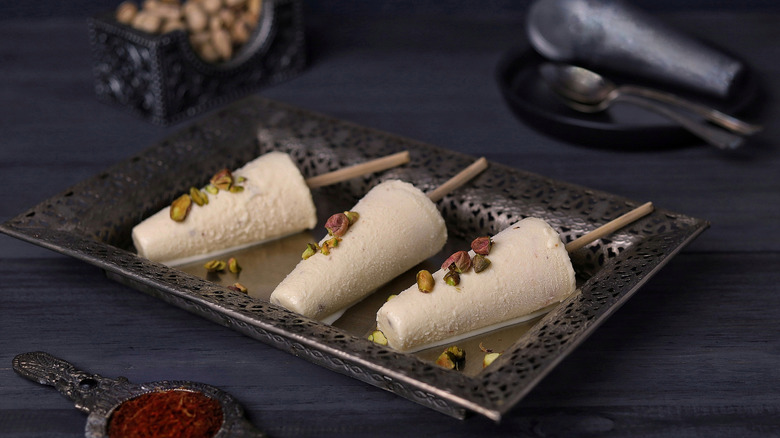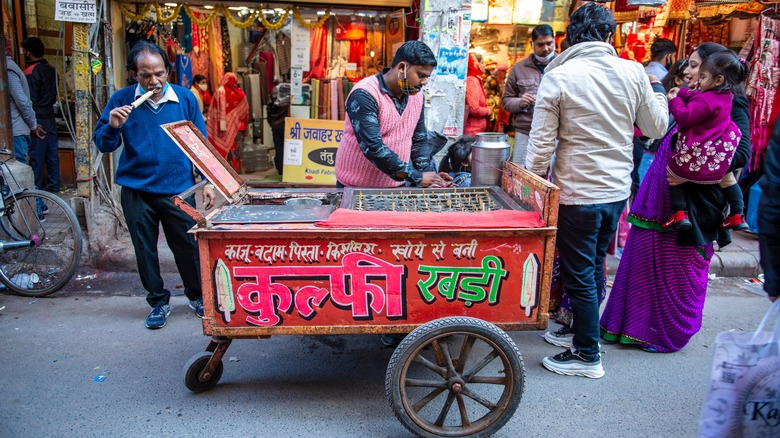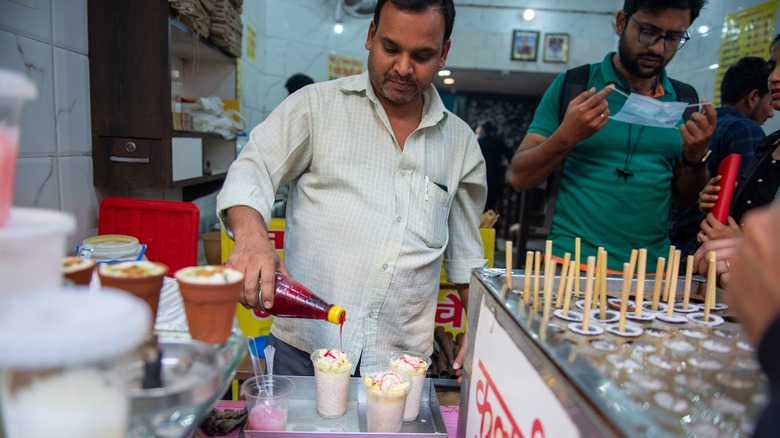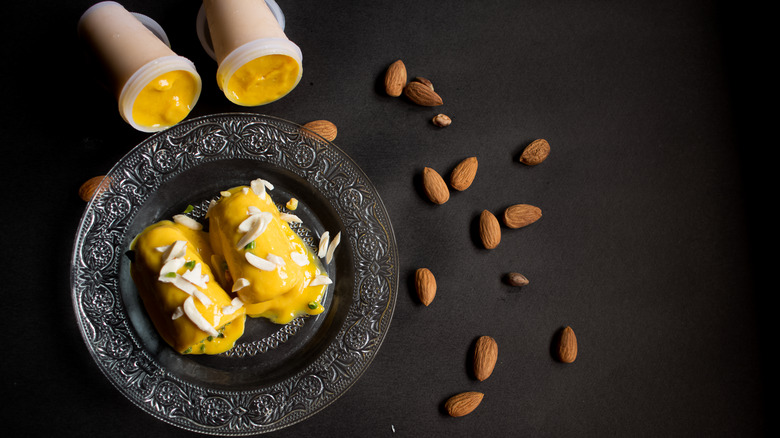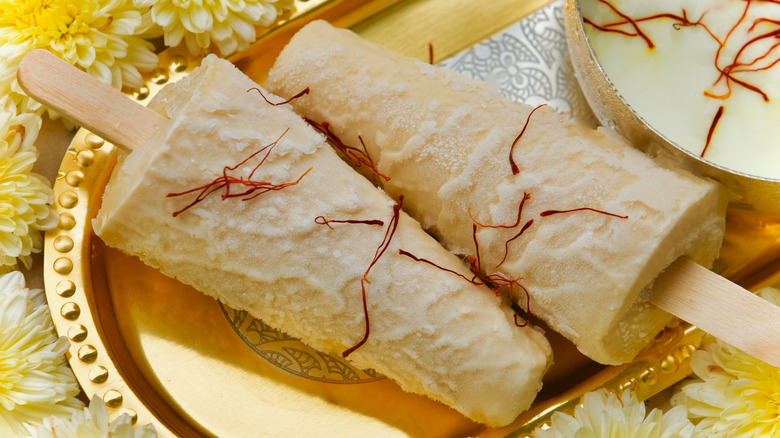Kulfi: The South Asian Frozen Custard You Can't Miss
At first glance, kulfi appears to be a type of ice cream; however, there are many differences between the dessert that is popular in South Asia and the rich dairy dessert served by the scoop on a cone. While some people refer to kulfi as "Indian ice cream," per Bon Appétit, kulfi and ice cream differ in texture, and kulfi is traditionally made from malai, a clotted cream.
Another aspect of kulfi that sets it apart from ice cream is the flavors that are typically given to it, as well as how it is served, according to Taste of Home. You are just as likely to see it served in a bowl or on a popsicle stick (via India.com). Whether you indulge in kulfi from a store in India or at a restaurant where you live, the flavor-packed kulfi is a perfect treat on a hot day.
The history of kulfi
The origin story of kulfi is believed to lie with the Mughal Empire and the long-ago inhabitants of the Himalayas, per Taste Atlas. The Mughals ruled from about 1556 to 1707 in what is now India, per Britannica, and it is thought the Mughals came up with a way to season evaporated milk and then freeze it in cones (via Whisk Taker). With India being a hot country with no ice for freezing the dessert, there are a couple of thoughts on how kulfi was made, either with ice sent from the mountains or by using a solution of saltpeter (potassium nitrate).
As the world evolved, so did how people got their kulfi. In India throughout the decades, there have been roadside vendors who sell the dessert from their carts and they are called "kulfiwallah," per Swasthi's Recipes, although some people took on the task of making the dairy dessert themselves at home. As Indians immigrated to other countries, they opened restaurants that also served kulfi. For Indian immigrants, homemade kulfi had to be made differently because the traditional ingredients weren't always available. Antara Sinha wrote for Bon Appétit that her mother adapted the recipe to what could be found in her Texan grocery store and incorporated frozen Cool Whip and canned condensed milk.
How kulfi is made
To make kulfi, you start by boiling the milk in a pan on the stove for about 10 to 11 minutes, per Swasthi's Recipes. Next, add four tablespoons of sugar as you continue to stir and boil the milk for another 10 minutes. While that is cooking, add two teaspoons of cornstarch to a cup of milk and mix together so there are no lumps. This mixture will then be added to the pan followed by bringing the contents of the pan back to a boil, according to Swasthi's Recipes. It's at this point that you add the nuts and seasonings to the pan and stir while the liquid is simmering. Then, Swasthi's Recipes says to add cream, but that can be omitted and instead, the mixture can be simmered longer to thicken. Finally, the kulfi mixture is allowed to cool and then placed into molds for freezing, which should take about eight to 12 hours. The last step is to sprinkle some pistachio nuts on top.
Other recipes are similar. India.com recommends using sweetened or flavored milk which is cooked slowly, constantly stirring, until it becomes thick and the volume is halved. They say this caramelizes the lactose and sugar to give it its distinctive flavor. The kulfi is then poured into molds and frozen in a container filled with ice and salt for a slow freezing process. They further note that today kulfi is often made with heavy cream, evaporated milk, or sweetened condensed milk. Additionally, fillers like bread crumbs or a water and cornstarch paste can be added to make it thicken more quickly.
How kulfi is served
In South Asia, kulfi is traditionally served in a small pot called a "matka," per Bon Appétit, or on a wooden stick like a popsicle.
If someone bites into kulfi expecting something smooth and whipped, they will be surprised. Instead, it often has chunks of nuts and fruit incorporated into the dessert. After the kulfi has been made and shaped (whether in a bowl or on a stick), nut toppings are generally added. Bon Appétit recommends adding chopped pistachios to the top, while Taste of Home incorporates pistachios and cashews.
Mishry says that kulfi molds come with lids with an attached stick. Molds can be made of plastic, aluminum, or other metals and are generally freezer safe. The shape of molds can vary from long and slim to shorter and broader. Usually, they will hold about 90-120 milliliters of fluid.
What does kulfi taste like?
Kulfi can be a wide range of flavors, but they tend to be of a more savory nature. The Spice People says ground cardamon and rose water are added to kulfi to give it a distinct flavor and then it can be topped with chopped pistachios. Other flavor variations are made with saffron, mango puree, and ground almonds. Kulfi maker and distributor Shahi Kulfi makes the dessert in a variety of flavors, including chocolate, coconut, pistachio, strawberry, mango, and malai.
Spicy and nutty is how Taste of Home describes the dessert and it uses whole milk instead of heavy cream for the base. It can also take on a caramelized flavor, per Taste Atlas, as well as nutty. When comparing kulfi to ice cream, the South Asian dessert is denser thanks to the method of making it by slowly cooking milk on the stovetop until it has become thick, per Swasthi's Recipes. The finished product can be compared to a British sherbet or a creamsicle. A bonus to kulfi compared to ice cream is that because it is denser, it is slower to melt, according to Bon Appétit.
